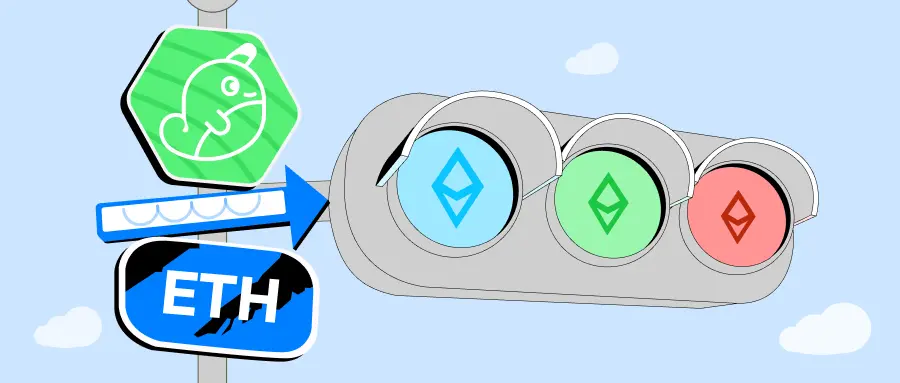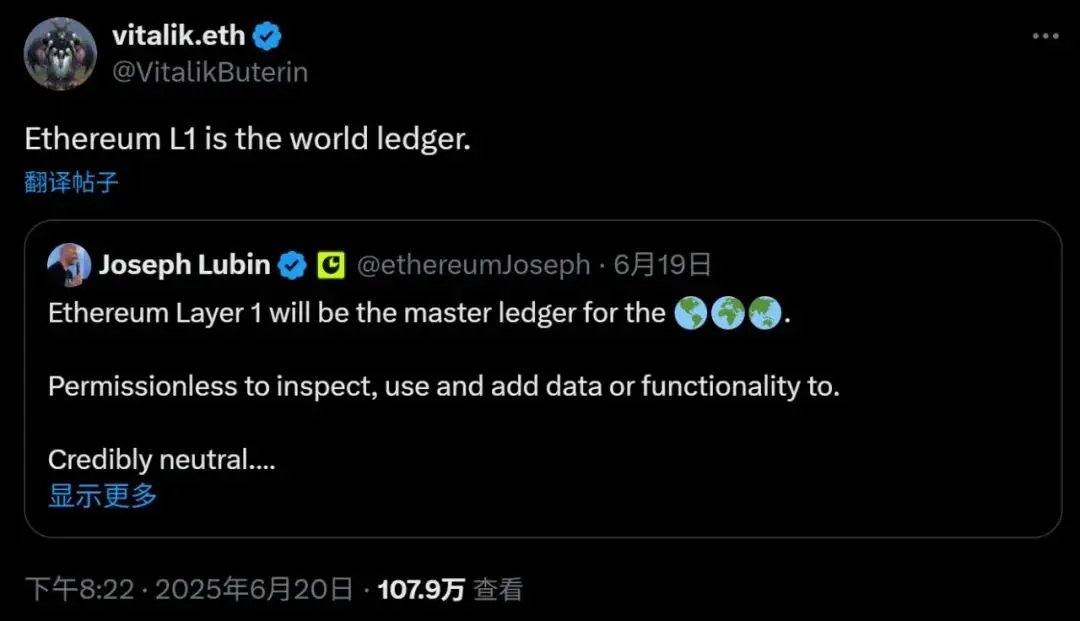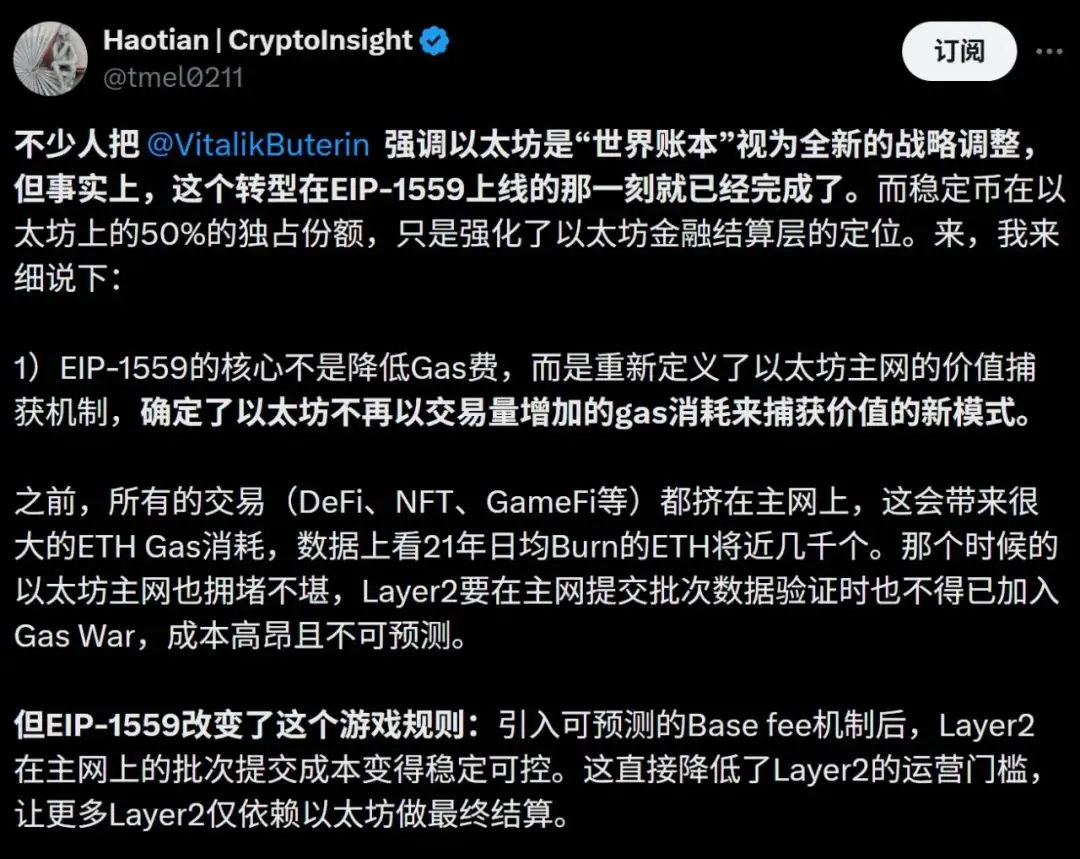
On June 20, Ethereum founder Vitalik Buterin reposted a tweet by ConsenSys founder Joseph Lubin, stating that "Ethereum L1 is the world ledger".

This is a rare statement by Vitalik regarding recent discussions about Ethereum's macro narrative.
It is well known that in the blockchain world, each public chain essentially has a design positioning that often defines its technical architecture and ecosystem style.
For example, since its inception, Ethereum's ultimate vision has been to build a "world computer": an open platform that can run any smart contract and carry various Web3 application logics. Vitalik has also clearly pointed out that Ethereum is not just a payment network, but a universal decentralized computing layer.
So now, from "world computer" to "world ledger", what narrative changes has it gone through?
01, Ethereum: The Original Intention of the World Computer
In fact, not just Ethereum, even Bitcoin, which initially proposed the "Electronic Cash" vision, has gradually shifted its payment positioning with growth and market evolution, turning towards "digital gold" focused on value storage.
Objectively, this transformation is a pragmatic choice, as BTC, representing the breakthrough of crypto assets, has been substantially incorporated into mainstream financial institutions' balance sheets, gradually becoming a core asset in TradFi allocation.
Looking back at Ethereum's development path, we find that while the main line hasn't undergone a drastic narrative change, it has been in continuous dynamic evolution:
In each market cycle since 2016, Ethereum has led the entire track as the head of smart contract platforms, giving birth to numerous on-chain use cases, from ERC20 to DeFi, and then to Non-Fungible Tokens and chain games, with each wave confirming the charm of "on-chain computing power".
It can be said that smart contracts have always been its core, which is why Vitalik has repeatedly emphasized that Ethereum is a decentralized application platform aimed at carrying various Web3 native logics, not just asset transfers. However, we also see the contradictions in reality.
The most criticized issues were naturally the high gas fees and low TPS performance that limited the large-scale implementation of truly complex computational logic. It was in this context that Rollup technology gradually emerged from 2020, and after five years of development, Ethereum has gradually established an "L1+L2" layered structure.
Under this architecture, especially in the past two years, more and more signs indicate that Ethereum is revealing its potential to become a trusted, stable, sovereign-level "world ledger".
02, Narrative Reconstruction Under L1+L2 Division of Labor
If summarized in one sentence, "Ethereum mainnet is responsible for security and settlement, while L2 handles high-frequency interactions" would be most apt.
Simply put, a clear division of labor has now formed within the Ethereum ecosystem: the mainnet provides infrastructure guarantees for security and final settlement, while L2 (such as Base, Arbitrum, Optimism, etc.) carries most high-frequency transactions and user operations.
This approach not only improves scalability but also further strengthens ETH's value capture logic, naturally pushing the Ethereum mainnet towards a "global decentralized ledger" positioning. The more L2 networks, the more successful and prosperous the ecosystem, the higher the value of the Ethereum mainnet as a unified grand ledger.
After all, all L2 networks rely on it as a "central bank" level settlement layer.

As Web3 researcher Haotian said, EIP-1559 is undoubtedly a key turning point in Ethereum's narrative, introducing not only Base Fee and burning mechanisms but also deeply reshaping Ethereum's value capture method, shifting from relying on gas income from numerous mainnet transactions to depending on L2's continuous "taxation".
In other words, users were previously direct customers of the mainnet, but now L2s act as agents, providing services to users, collecting fees, and ultimately "remitting" fees to the mainnet in exchange for settlement rights. This mechanism design is similar to the historical "tax farming system":
The mainnet becomes the final trusted ledger for transaction clearing and settlement, similar to a central bank;
L2s are like commercial banks, responsible for high-frequency services to users;
Each L2 transaction verified on the mainnet burns ETH, paying for the ledger's security;
It can be said that Ethereum hasn't abandoned its "world computer" vision, but the L1+L2 division of labor and development path are guiding it to first become a "world ledger".
03, Realistic Landing of the "World Ledger"
Another interesting observation is that each wave of ETH's value explosion actually stems from the mainnet's role as a ledger being "put to use".
Like the 2017 ERC20 wave was a Token issuance clearing layer, the 2020 DeFi Summer was a financial settlement platform under smart contract combinations, and the recent potential wave due to US stock tokenization and RWA would again see Ethereum as the trusted ledger.
Because for TradFi, computational power is certainly important, but what truly determines whether migration on-chain happens is always the ledger's "trust, finality, and security" - the core landing point for compliant assets.
This is why platforms like Robinhood are launching US stock token trading services on L2s like Arbitrum. This is not just an acknowledgment of Rollup architecture performance, but more importantly, these transactions will ultimately return to the Ethereum mainnet for settlement.
This also demonstrates that current L2 solutions' performance, security, and compliance capabilities are sufficient to handle traditional financial core asset trading needs. In a sense, this "US stocks on-chain" wave actually strengthens Ethereum's positioning as global financial clearing and settlement infrastructure, further validating the feasibility and real-world demand for its "world ledger" role.
This is the realistic pragmatic evolution path from "world computer" to "world ledger" - it no longer just promises a future on-chain application landscape, but is increasingly chosen by mainstream real-world assets as the settlement endpoint.
From this perspective, such trends not only confirm the value of Ethereum L1 but will also profoundly reconstruct L2's value capture logic, driving the entire Ethereum ecosystem to truly interface between technology and financial infrastructure.
In a word, the narratives that can truly drive this chain towards billions of users are not just about what Ethereum can do, but more about:
What the real world is willing to do with Ethereum.





